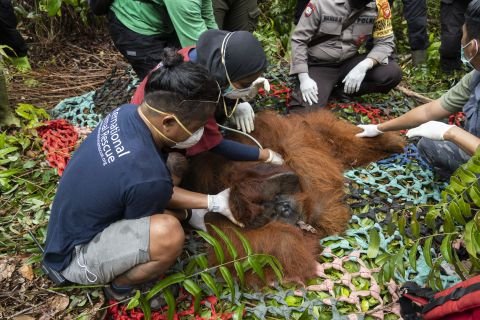
The team in Indonesia have translocated a huge male orangutan from residents’ gardens in West Borneo, Indonesia. A group from the Wildlife Rescue Unit (WRU) for the Natural Resources Conservation Agency (BKSDA Kalbar) and IAR Indonesia travelled to the gardens in Sungai Pelang Village in the District of Ketapang, West Kalimantan (Indonesian Borneo.)
Reports of the existence of the orangutan had come from a resident and IAR sent the Orangutan Protection Unit (OPU) Patrol Team to the location to verify the sightings. The team eventually spotted the orangutan whom they named Boncel and they started monitoring him at the beginning of August.
IAR’s team studied the orangutan’s location via satellite imagery and agreed that the distance between the location of the garden and the forest was too great for him to be driven back into the forest. In light of this – and in light of the potential risk of conflict between the orangutan and local residents, the IAR team and members of the BKSDA and local Government agreed he should be translocated to the nearby forest of Sungai Besar.
The translocation went smoothly. IAR veterinarian Dr Andiri Nurillah carried out a health check on the orangutan and pronounced him to be between 30-40 years old and in good condition apart from a fractured finger. He was estimated to weigh between 60-70kg.
“Because the orangutan is healthy and doesn’t require any medical treatment, we agreed with the team from BKSDA Kalbar that he should be translocated directly to the forest of Sungai Besar. We have also coordinated directly with the village authorities on this matter,” explained Argitoe Ranting, Head of the IAR Indonesia programme. “The forest covers an area of more than 6500 hectares.”
“Although such translocations offer a solution for individual orangutans, they are only a temporary solution. Translocation does not address the root of the problem which lies in the conversion and destruction of the forest,” he added.
Threats to the survival of the orangutan have increased since huge fires hit most major regions of Ketapang. Forest fires deprive orangutans of food and shelter. Inevitably orangutans are going to be displaced when they are driven out by fire and stray into villages and onto farmland in search of food. This causes an increase in the number of encounters between humans and orangutans which can lead to conflict and harm to both animals and people.
Karmele L Sanchez, Director of IAR Indonesia, said: ”On World Orangutan Day, 19th August, we were reminded that we should be proud to ave orangutans in the world and undertake whole hearted efforts to protect and preserve them and their habitats. However, conflicts between humans and orangutans continue to happen. Indeed, the potential for conflict is on the increase. Conflicts emerge because orangutans continue to lose the habitat that is home to them. Orangutans going in search of food end up on agricultural land because they do not have a choice.
“Habitat loss and human-orangutan conflict also increase the risk of disease transmission between humans and orangutans. Past pandemics are evidence of this. The conversion of habitat and the loss of biodiversity, as well as the increase in conflicts and interactions between animals and humans, become key factors contributing towards the increased risk of new emerging zoonotic diseases. If we want to protect orangutans and we want to protect humans from pandemics, we have to protect ecosystems and nature as a whole. We hope people will start to realise the importance of rainforests for orangutans and for humans too.”

